Impact of Salting Techniques on the Physio-Chemical Characteristics, Sensory Properties, and Volatile Organic Compounds of Ras Cheese
Abstract
1. Introduction
2. Materials and Methods
2.1. Materials
2.2. Ras Cheese Manufacture
2.3. Physio-Chemical Analysis of Ras Cheese
2.4. Sensory Evaluation
2.5. Assay of Volatile Organic Compounds (VOCs)
2.6. Statistical Analysis
3. Results
3.1. The Moisture Content of Ras Cheese
3.2. The Salt Content (%) of Ras Cheese
3.3. Ash Content of Ras Cheese
3.4. The Fat Content of Ras Cheese
3.5. Total Nitrogen Content of Ras Cheese
3.6. Acidity and pH Values of Ras Cheese
3.7. Sensory Evaluation of Ras Cheese
3.8. Volatile Compounds of Ras Cheese
4. Discussion
5. Conclusions
Author Contributions
Funding
Data Availability Statement
Acknowledgments
Conflicts of Interest
References
- Abou Donia, S.A. Recent Developments in Ras Cheese Research: A Review. Egypt. J. Dairy Sci. 2002, 30, 155–166. [Google Scholar]
- Singh, T.; Drake, M.; Cadwallader, K. Flavor of Cheddar Cheese: A Chemical and Sensory Perspective. Compr. Rev. Food Sci. Food Saf. 2003, 2, 166–189. [Google Scholar] [CrossRef]
- Awad, S. Texture and flavour development in Ras cheese made from raw and pasteurised milk. Food Chem. 2006, 97, 394–400. [Google Scholar] [CrossRef]
- Hattem, H.E.; Taleb, A.T.; Manal, A.N.; Hanaa, S.S. Effect of pasteurization and season on milk composition and ripening of Ras cheese. J. Brew. Distill. 2012, 3, 15–22. [Google Scholar] [CrossRef]
- El-Leboudy, A.A.; Amer, A.A.; Youssef, M.R. Assessment of Sanitary Measures of Ras Cheese in Manufacturing Dairy Plant in Alexandria Governorate. Alex. J. Vet. Sci. 2014, 40, 87–94. [Google Scholar]
- Gunasekaran, S.; Ak, M.M. Cheese Rheology and Texture; CRC Press: Boca Raton, FL, USA, 2002; ISBN 9781587160219. [Google Scholar]
- Fox, P.F.; Cogan, T.M. Factors that affect the quality of cheese. In Cheese: Chemistry, Physics and Microbiology; Fox, P.F., McSweeney, P.L.H., Cogan, T.M., Guinee, T.P., Eds.; Elsevier: Amsterdam, The Netherlands, 2004; Volume 1, pp. 583–608. [Google Scholar]
- Guinee, T.P. Salting and the role of salt in cheese. Int. J. Dairy Technol. 2004, 57, 99–109. [Google Scholar] [CrossRef]
- Johnson, M.E.; Kapoor, R.; McMahon, D.J.; McCoy, D.R.; Narasimmon, R.G. Reduction of Sodium and Fat Levels in Natural and Processed Cheeses: Scientific and Technological Aspects. Compr. Rev. Food Sci. Food Saf. 2009, 8, 252–268. [Google Scholar] [CrossRef] [PubMed]
- Kaminarides, S.; Moschopoulou, E.; Karali, F. Influence of Salting Method on the Chemical and Texture Characteristics of Ovine Halloumi Cheese. Foods 2019, 8, 232. [Google Scholar] [CrossRef] [PubMed]
- Guinee, T.P.; Fox, P.F. Salt in cheese: Physical, chemical and biological aspects. In Cheese: Chemistry, Physics and Microbiology; Fox, P.F., McSweeney, P.L.H., Cogan, T.M., Guinee, T.P., Eds.; Elsevier: Amsterdam, The Netherlands, 2004; Volume 1, pp. 207–259. [Google Scholar]
- El-bakry, M. Sodium in Different Cheese Types: Role and Strategies of Reduction. Cheese Ttpes Nutr. Consum. 2011, 3, 105–118. [Google Scholar]
- Delahunty, C.M.; Piggott, J.R. Current Methods to Evaluate Contribution and Interactions of Components to Flavour of Solid Foods Using Hard Cheese as an Example. Int. J. Food Sci. Technol. 1995, 30, 555–570. [Google Scholar] [CrossRef]
- Bae, I.; Park, J.-H.; Choi, H.-Y.; Jung, H.-K. Emerging Innovations to Reduce the Salt Content in Cheese; Effects of Salt on Flavor, Texture, and Shelf Life of Cheese; and Current Salt Usage: A Review. Korean J. Food Sci. Anim. Resour. 2017, 37, 793–798. [Google Scholar] [CrossRef]
- Kaminarides, S.; Stamou, P.; Massouras, T. Changes of organic acids, volatile aroma compounds and sensory characteristics of Halloumi cheese kept in brine. Food Chem. 2007, 100, 219–225. [Google Scholar] [CrossRef]
- Hassan, F.A.; El-Gawad, M.A.A.; Enab, A. Flavour compounds in cheese (review). Int. J. Acad. Res. 2012, 4, 169–181. [Google Scholar] [CrossRef]
- McSweeney, P.L.; Sousa, M.J. Biochemical Pathways for the Production of Flavour Compounds in Cheeses during Ripening: A Review. Lait 2000, 80, 293–324. [Google Scholar] [CrossRef]
- Østergaard, S.; Krogh, M.A.; Oliveira, V.H.S.; Crowe, M.; McLoughlin, N.; Fahey, A.; Carter, F.; Matthews, E.; Santoro, A.; Byrne, C.; et al. Only few benefits from propylene glycol drench in early lactation for cows identified as physiologically imbalanced based on milk spectra analyses. J. Dairy Sci. 2020, 103, 1831–1842. [Google Scholar] [CrossRef]
- Garde, S.; Tomillo, J.; Gaya, P.; Medina, M.; Nuñez, M. Proteolysis in Hispánico Cheese Manufactured Using a Mesophilic Starter, a Thermophilic Starter, and Bacteriocin-Producing Lactococcus lactis Subsp. lactis INIA 415 Adjunct Culture. J. Agric. Food Chem. 2002, 50, 3479–3485. [Google Scholar] [CrossRef] [PubMed]
- Engels, W.; Dekker, R.; de Jong, C.; Neeter, R.; Visser, S. A comparative study of volatile compounds in the water-soluble fraction of various types of ripened cheese. Int. Dairy J. 1997, 7, 255–263. [Google Scholar] [CrossRef]
- Lazzi, C.; Povolo, M.; Locci, F.; Bernini, V.; Neviani, E.; Gatti, M. Can the development and autolysis of lactic acid bacteria influence the cheese volatile fraction? The case of Grana Padano. Int. J. Food Microbiol. 2016, 233, 20–28. [Google Scholar] [CrossRef] [PubMed]
- Fox, P.F. Chemistry And Biochemistry; CRC Press: Boca Raton, FL, USA, 2009; ISBN 9783319148915. [Google Scholar]
- Bonomo, M.G.; Cafaro, C.; Salzano, G. Genotypic and technological diversity of Brevibacterium linens strains for use as adjunct starter cultures in ‘Pecorino di Filiano’ cheese ripened in two different environments. Folia Microbiol. 2015, 60, 61–67. [Google Scholar] [CrossRef]
- Pedersen, T.B.; Vogensen, F.K.; Ardö, Y. Effect of heterofermentative lactic acid bacteria of DL-starters in initial ripening of semi-hard cheese. Int. Dairy J. 2016, 57, 72–79. [Google Scholar] [CrossRef]
- Vélez, M.A.; Perotti, M.C.; Wolf, I.V.; Hynes, E.R.; Zalazar, C.A. Influence of milk pretreatment on production of free fatty acids and volatile compounds in hard cheeses: Heat treatment and mechanical agitation. J. Dairy Sci. 2010, 93, 4545–4554. [Google Scholar] [CrossRef]
- Brown, J.A.; Foegeding, E.A.; Daubert, C.R.; Drake, M.A.; Gumpertz, M. Relationships Among Rheological and Sensorial Properties of Young Cheeses. J. Dairy Sci. 2003, 86, 3054–3067. [Google Scholar] [CrossRef] [PubMed]
- Hofi, A.; Youssef, E.; Ghoneim, M.; Tawab, G. Ripening Changes in Cephalotyre “RAS” Cheese Manufactured from Raw and Pasteurized Milk with Special Reference to Flavor. J. Dairy Sci. 1970, 53, 1207–1211. [Google Scholar] [CrossRef]
- El-Hamshary, H.; Awad, S.; El-Hawary, M.; Amer, D. Impact of some Salting Methods on the Quality of Ras Cheese. Alex. Sci. Exch. J. 2022, 43, 169–178. [Google Scholar] [CrossRef]
- Association of Official Analytical Chemists. Official Methods of Analysis; Association of Official Analytical Chemists: Arlington, VA, USA, 2020. [Google Scholar]
- Pearson, D. Laboratory Techniques in Food Analysis (National College of Food Technology, Univ. of Reading, Weybridge, Surrey, UK) John Wiley and Sons, New York and Toronto. J. Chromatogr. Sci. 1975, 13, 18A. [Google Scholar] [CrossRef]
- Pearson, D. The Chemical Analysis of Foods; Longman Group Ltd.: Weybridge, UK, 1976; ISBN 0443014. [Google Scholar]
- Ayad, E.H.E.; Awad, S.; El Attar, A.; de Jong, C.; El-Soda, M. Characterisation of Egyptian Ras cheese. 2. Flavour formation. Food Chem. 2004, 86, 553–561. [Google Scholar] [CrossRef]
- Abbas, K.A.; Agamy, A.A.; Metry, W.A. Evaluation of Changes of the Chemical, Rheological and Organoleptic Characteristics of Ras Cheese during Ripening. J. Food Dairy Sci. 2017, 8, 391–394. [Google Scholar] [CrossRef]
- Hannon, J.A.; Kilcawley, K.N.; Wilkinson, M.G.; Delahunty, C.M.; Beresford, T.P. Flavour precursor development in Cheddar cheese due to lactococcal starters and the presence and lysis of Lactobacillus helveticus. Int. Dairy J. 2007, 17, 316–327. [Google Scholar] [CrossRef]
- Khattab, A.R.; Guirguis, H.A.; Tawfik, S.M.; Farag, M.A. Cheese ripening: A review on modern technologies towards flavor enhancement, process acceleration and improved quality assessment. Trends Food Sci. Technol. 2019, 88, 343–360. [Google Scholar] [CrossRef]
- Abd-Alla, A.-E.; Abd-Alla, A.-E.A.; El-Gendy, S.M.; El-Gazzar, F.E.; Ibrahim, E.M. Qualty Enhancement of RAS Cheese with Sodium Chloride and/or Potassium Chlodide. Int. J. Agric. Ext. Rural Dev. Stud. 2017, 5, 9–21. [Google Scholar]
- Aminifar, M.; Emam-Djomeh, Z. Changes OfTexture, Microstructure and Free Fatty Acid Contents of Lighvan Cheese During Accelerated Ripening with Lipase. J. Agric. Sci. Technol. 2014, 16, 113–123. [Google Scholar]
- Miķelsone, A.; Ciproviča, I. Effect of Ripening Conditions on Latvian Semi-Hard Cheese Quality. Cheminé Technol. 2009, 3, 93–97. [Google Scholar]
- Nateghi, L. Identification and Quantification of Key Volatile Flavor Compounds Employing Different Adjunct Starter Cultures in Reduced-fat Cheddar Cheeses by Using GC and GC-MS. Appl. Food Biotechnol. 2017, 4, 43–52. [Google Scholar] [CrossRef]
- Pappa, E.C.; Massouras, T.; Sotirakoglou, K.; Kandarakis, I. Formation of volatile compounds in Teleme cheese manufactured with mesophilic and thermophilic dairy starters. Small Rumin. Res. 2012, 111, 110–119. [Google Scholar] [CrossRef]
- Zotta, T.; Eissa Kheadr, E.; Filannino, P.; Wang, B.; Li, J.; Huang, Q.; Zheng, X.; Ge, Z.; Lin, K.; Zhang, D.; et al. Investigation of the Lactic Acid Bacteria in Kazak Cheese and Their Contributions to Cheese Fermentation. Front. Microbiol. 2020, 11, 228. [Google Scholar] [CrossRef]
- Imhof, R.; Glättli, H.; Bosset, J. Volatile organic compounds produced by thermophilic and mesophilic single strain dairy starter cultures. LWT 1995, 28, 78–86. [Google Scholar] [CrossRef]
- Gao, S.; Oh, D.H.; Broadbent, J.R.; Johnson, M.E.; Weimer, B.C.; Steele, J.L. Aromatic Amino Acid Catabolism by Lactococci. Lait 1997, 77, 371–381. [Google Scholar] [CrossRef]
- Hamdy, S.; Shaaban, H.; Ali, H.S.; Mahmoud, H.S.; Abbas, K.; Farouk, A. Preparation of Ras Cheese Flavour Concentrate using Lipolyzed Cream and Skim Milk Curd. Int. J. Dairy Sci. 2017, 12, 275–281. [Google Scholar] [CrossRef]
- Molimard, P.; Spinnler, H.E. Review: Compounds Involved in the Flavor of Surface Mold-Ripened Cheeses: Origins and Properties. J. Dairy Sci. 1996, 79, 169–184. [Google Scholar] [CrossRef]
- Hayaloglu, A.A.; Brechany, E.Y. Influence of Milk Pasteurization and Scalding Temperature OnThe Volatile Compounds of Malatya, a Farmhouse Halloumi-Type Cheese. Lait 2007, 87, 39–57. [Google Scholar] [CrossRef]
- McSweeney, P.L.H. Cheese: Biochemistry of Cheese Ripening, 2nd ed.; Elsevier Inc.: Amsterdam, The Netherlands, 2011; pp. 667–674. [Google Scholar]
- Cakmakci, S.; Gundogdu, E.; Hayaloglu, A.A.; Dagdemir, E.; Gurses, M.; Cetin, B.; Tahmas-Kahyaoglu, D. Chemical and microbiological status and volatile profiles of mouldy Civil cheese, a Turkish mould-ripened variety. Int. J. Food Sci. Technol. 2012, 47, 2405–2412. [Google Scholar] [CrossRef]
- Dimitrellou, D.; Kandylis, P.; Mallouchos, A.; Komaitis, M.; Koutinas, A.A.; Kourkoutas, Y. Kourkoutas Effect of Freezedried Kefir Culture on Proteolysis in Fetatype and Whey-Cheeses. Food Chem. 2010, 119, 795–800. [Google Scholar] [CrossRef]
- Gobbetti, M.; De Angelis, M.; Di Cagno, R.; Mancini, L.; Fox, P.F. Pros and cons for using non-starter lactic acid bacteria (NSLAB) as secondary/adjunct starters for cheese ripening. Trends Food Sci. Technol. 2015, 45, 167–178. [Google Scholar] [CrossRef]
- Pagthinathan, M.; Ghazali, H.M.; Yazid, A.M.; Foo, H.L. Extraction, Purification and Characterisation of a Milk-Clotting Protease from “Kesinai” (Streblus Asper Lour) Leaves. Int. Food Res. J. 2019, 26, 913–922. [Google Scholar]
- Farag, I.; Amer, A.; Makarem, H. Biogenic Amines Pattern in Ras Cheese During Ripening Period. Alex. J. Veter. Sci. 2019, 61, 93. [Google Scholar] [CrossRef]
- Yvon, M.; Rijnen, L. Cheese Flavour Formation by Amino Acid Catabolism. Int. Dairy J. 2011, 11, 85–201. [Google Scholar] [CrossRef]
- Ayad, E.H.; Verheul, A.; Wouters, J.T.; Smit, G. Population dynamics of lactococci from industrial, artisanal and non-dairy origins in defined strain starters for Gouda-type cheese. Int. Dairy J. 2001, 11, 51–61. [Google Scholar] [CrossRef]
- Collins, Y.F.; McSweeney, P.L.H.; Wilkinson, M.G. Lipolysis and free fatty acid catabolism in cheese: A review of current knowledge. Int. Dairy J. 2003, 11, 841–866. [Google Scholar] [CrossRef]
- Thierry, A.; Collins, Y.F.; Mukdsi, M.A.; McSweeney, P.L.; Wilkinson, M.G.; Spinnler, H.E. Lipolysis and Metabolism of Fatty Acids in Cheese (Fourth edition). Chem. Phys. Microbiol. 2017, 423–444. [Google Scholar]
- Pagthinathan, M.; Nafees, M. Biochemistry of cheese ripening. AGRIEAST J. Agric. Sci. 2017, 10, 16. [Google Scholar] [CrossRef]
- Rowney, M.K.; Roupas, P.; Hickey, M.W.; Everett, D.W. Salt-induced structural changes in 1-day old Mozzarella cheese and the impact upon free oil formation. Int. Dairy J. 2004, 14, 809–816. [Google Scholar] [CrossRef]
- Sheibani, A.; Mishra, V.; Stojanovska, L.; Ayyash, M.M. Salt in Cheese: Health Issues, Reduction, Replacement and Release; Castelli, H., du Vale, L., Eds.; Nova Science Publishers, Inc.: Hauppauge, NY, USA, 2013; pp. 397–418. [Google Scholar]
- Grummer, J.; Schoenfuss, T. Determining salt concentrations for equivalent water activity in reduced-sodium cheese by use of a model system. J. Dairy Sci. 2011, 94, 4360–4365. [Google Scholar] [CrossRef] [PubMed]
- El-Bakry, M. Salt in Cheese: A Review. Curr. Res. Dairy Sci. 2012, 4, 1–5. [Google Scholar] [CrossRef]
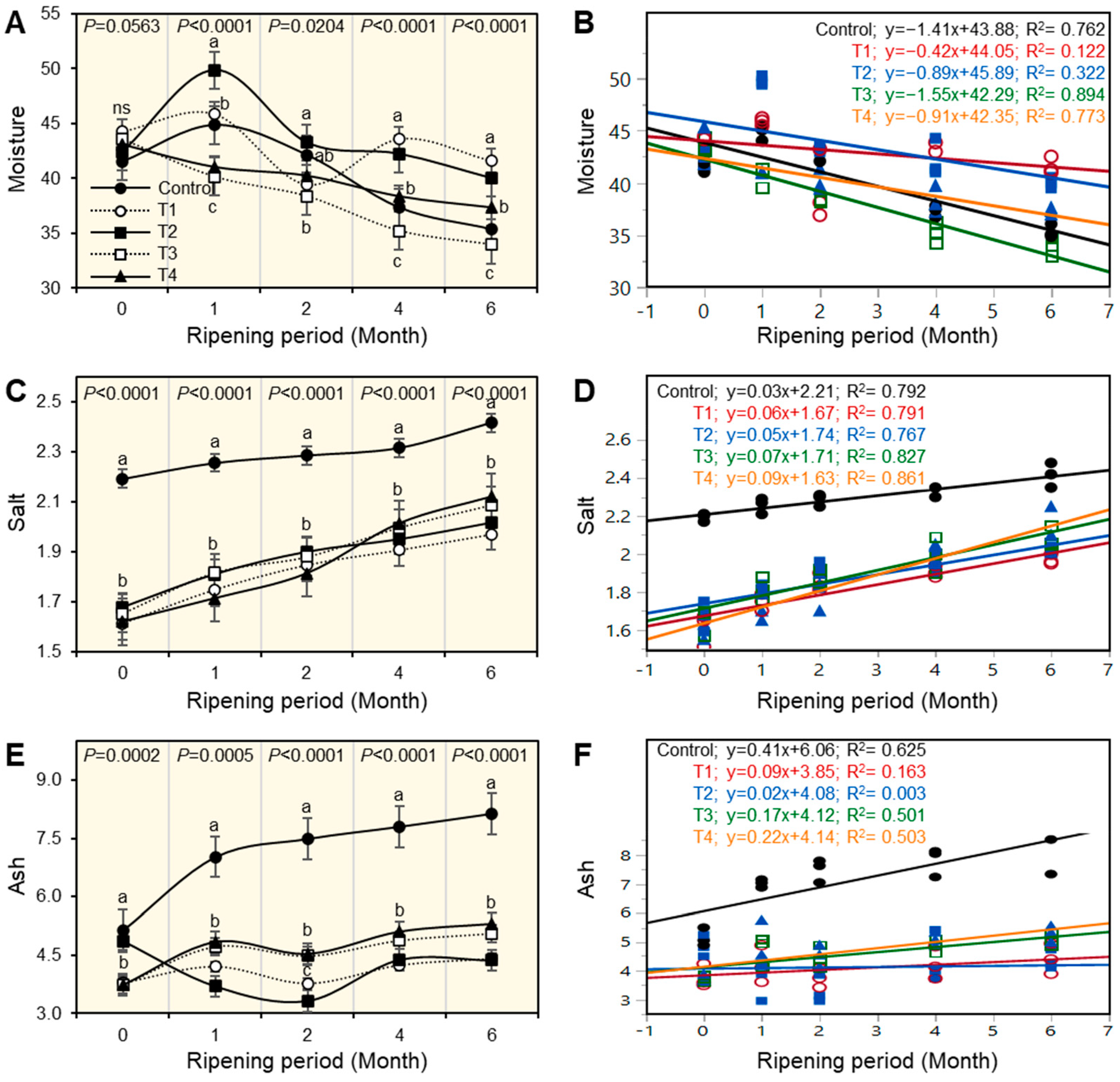
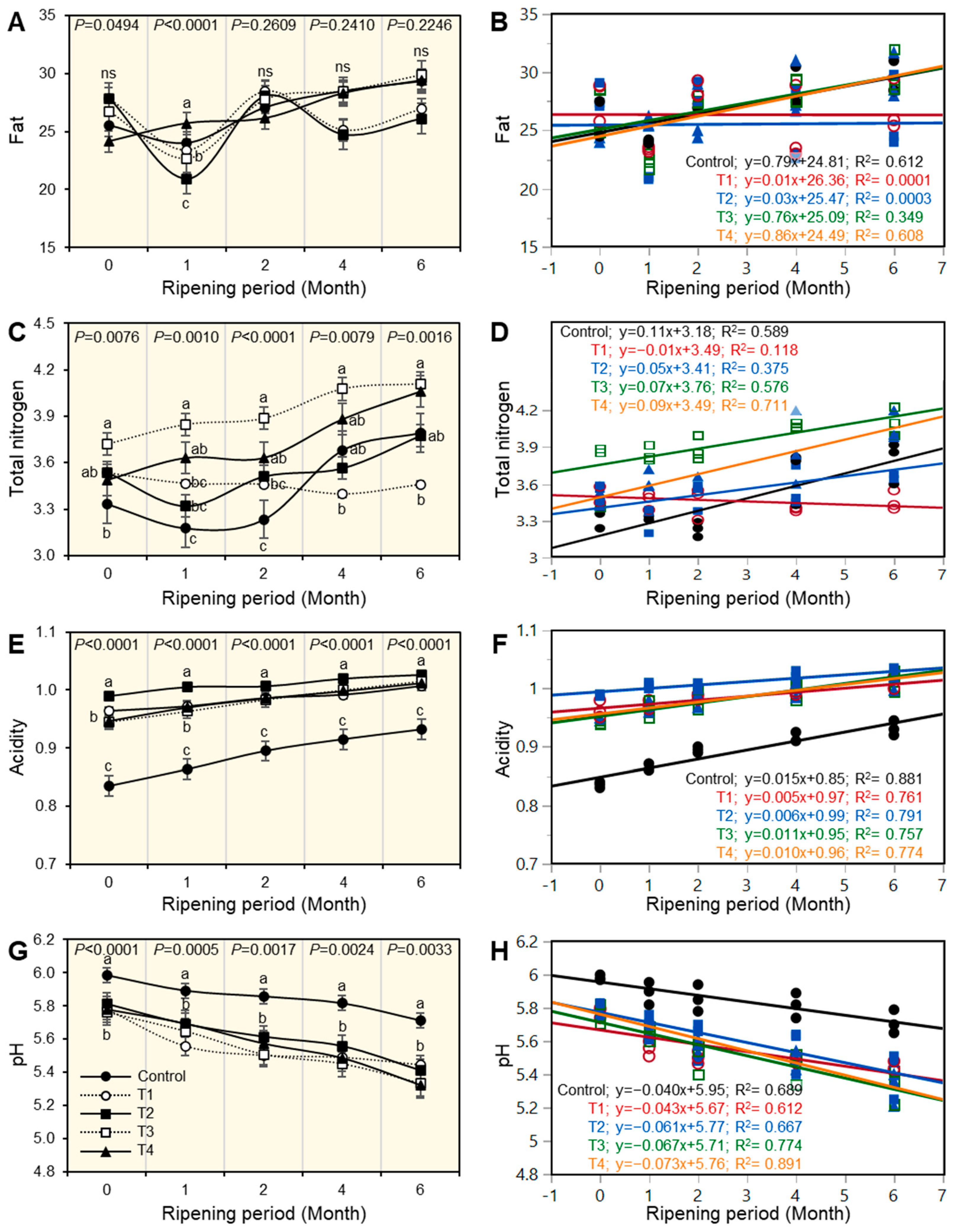
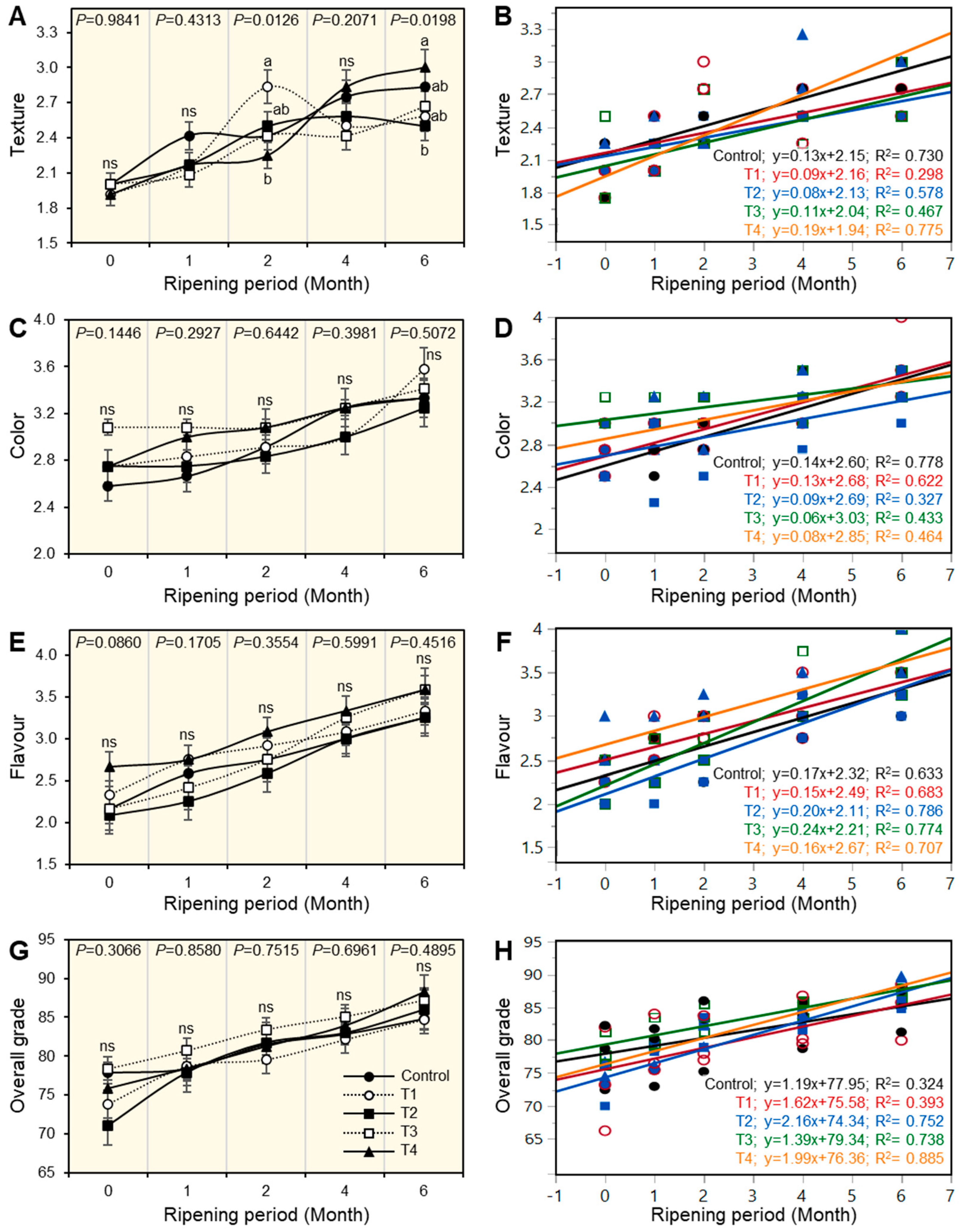
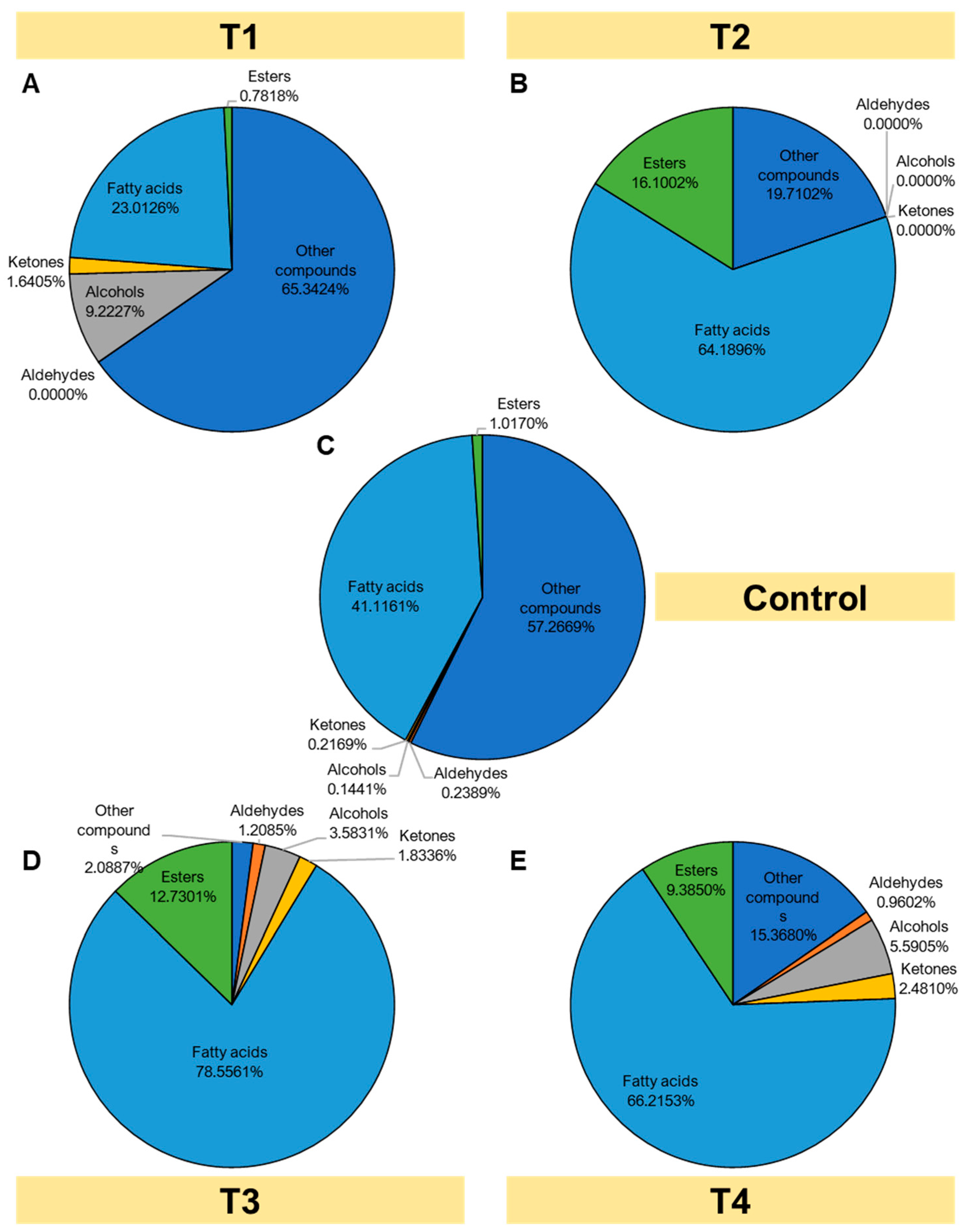
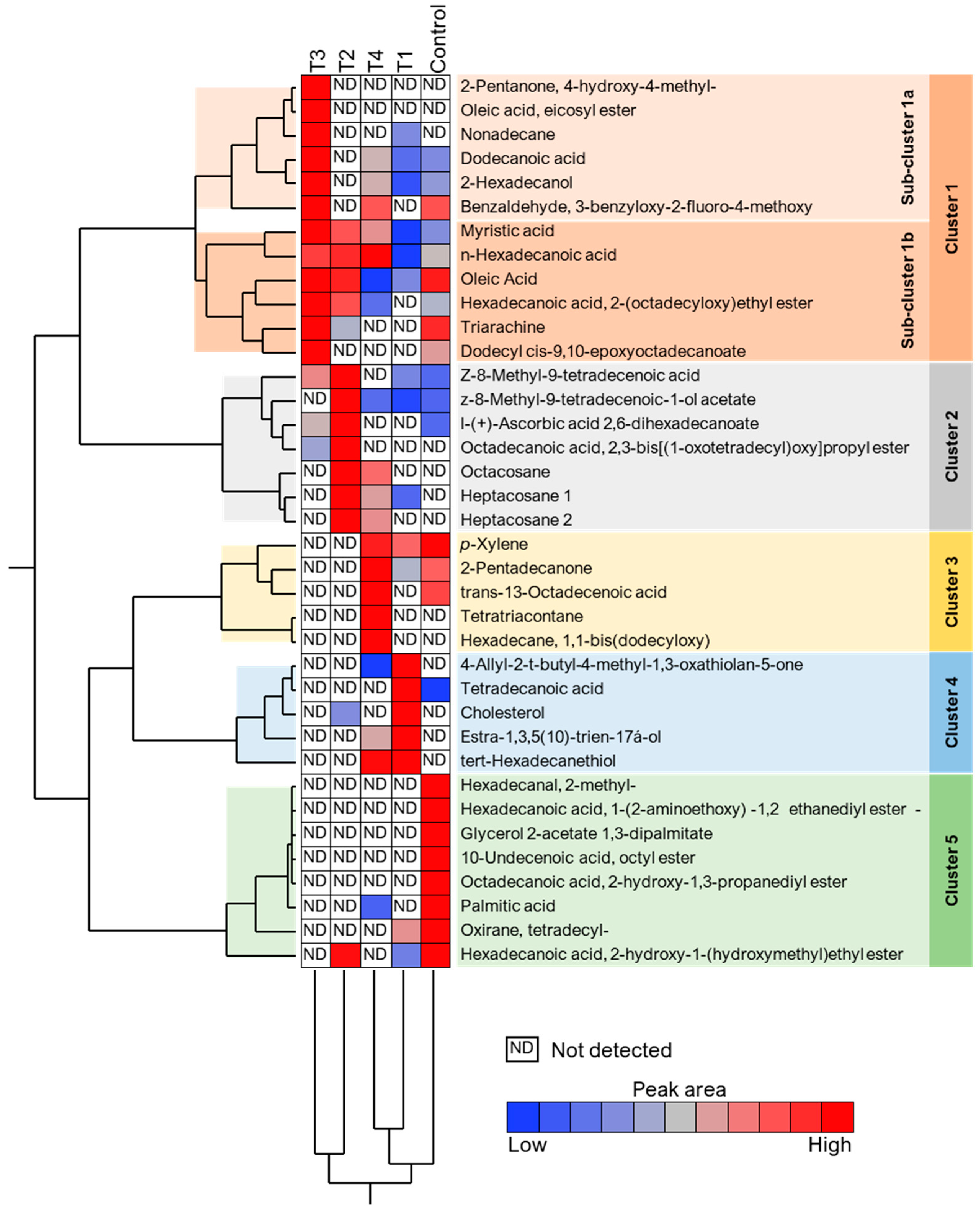
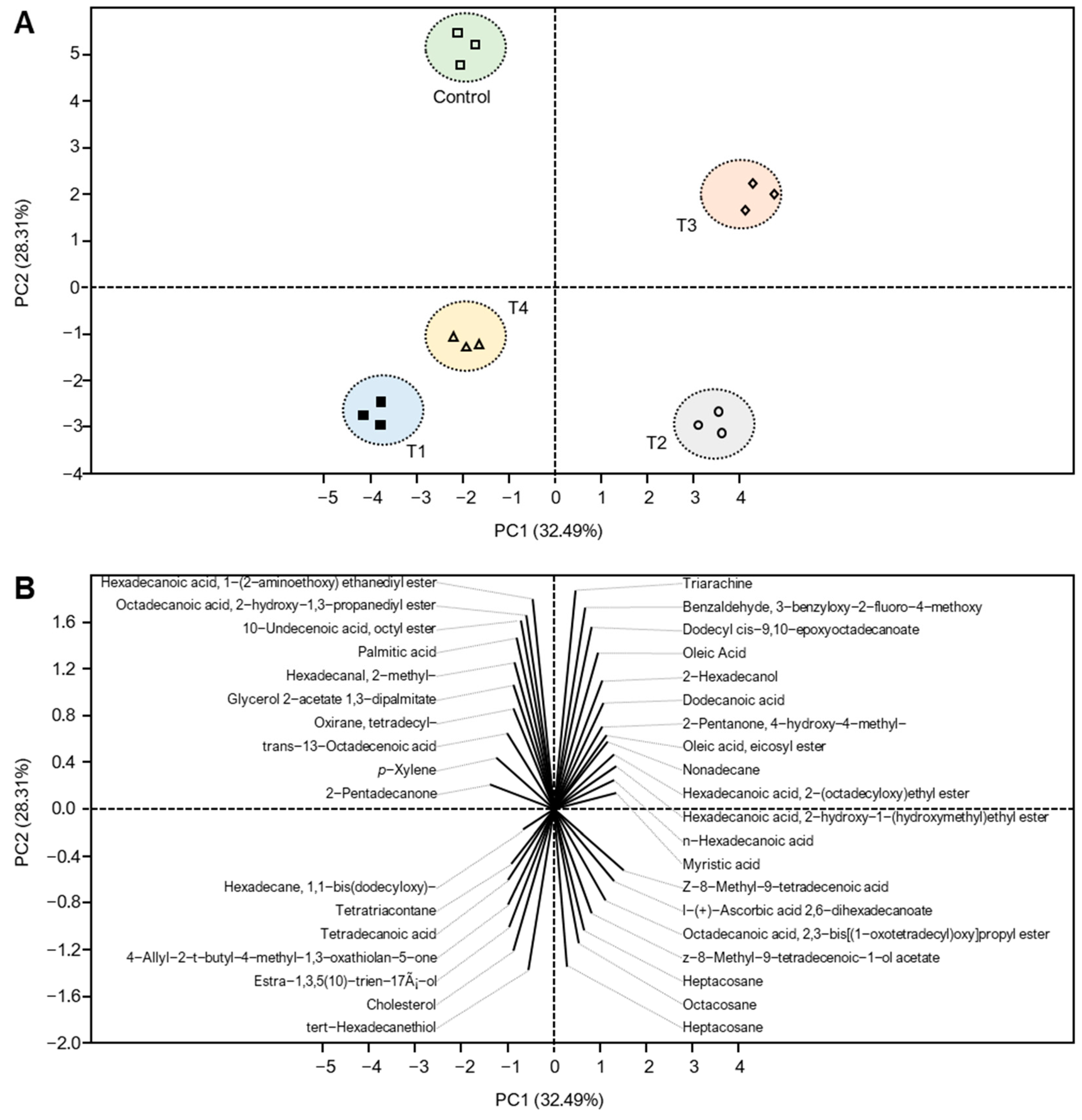

Disclaimer/Publisher’s Note: The statements, opinions and data contained in all publications are solely those of the individual author(s) and contributor(s) and not of MDPI and/or the editor(s). MDPI and/or the editor(s) disclaim responsibility for any injury to people or property resulting from any ideas, methods, instructions or products referred to in the content. |
© 2023 by the authors. Licensee MDPI, Basel, Switzerland. This article is an open access article distributed under the terms and conditions of the Creative Commons Attribution (CC BY) license (https://creativecommons.org/licenses/by/4.0/).
Share and Cite
Amer, D.A.; Albadri, A.A.M.; El-Hamshary, H.A.; Nehela, Y.; El-Hawary, M.Y.; Makhlouf, A.H.; Awad, S.A. Impact of Salting Techniques on the Physio-Chemical Characteristics, Sensory Properties, and Volatile Organic Compounds of Ras Cheese. Foods 2023, 12, 1855. https://doi.org/10.3390/foods12091855
Amer DA, Albadri AAM, El-Hamshary HA, Nehela Y, El-Hawary MY, Makhlouf AH, Awad SA. Impact of Salting Techniques on the Physio-Chemical Characteristics, Sensory Properties, and Volatile Organic Compounds of Ras Cheese. Foods. 2023; 12(9):1855. https://doi.org/10.3390/foods12091855
Chicago/Turabian StyleAmer, Dina A., Abdinn A. M. Albadri, Hanaa A. El-Hamshary, Yasser Nehela, Mohamed Y. El-Hawary, Abeer H. Makhlouf, and Sameh A. Awad. 2023. "Impact of Salting Techniques on the Physio-Chemical Characteristics, Sensory Properties, and Volatile Organic Compounds of Ras Cheese" Foods 12, no. 9: 1855. https://doi.org/10.3390/foods12091855
APA StyleAmer, D. A., Albadri, A. A. M., El-Hamshary, H. A., Nehela, Y., El-Hawary, M. Y., Makhlouf, A. H., & Awad, S. A. (2023). Impact of Salting Techniques on the Physio-Chemical Characteristics, Sensory Properties, and Volatile Organic Compounds of Ras Cheese. Foods, 12(9), 1855. https://doi.org/10.3390/foods12091855






